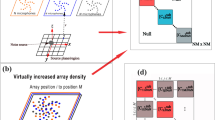Abstract
We investigated the acoustical information present in the field of arbitrary sound sources which may provide direction and distance to the source from a local reading of the sound field parameters. If the effects of reflections are negligible, the particle acceleration is directed radially at the instant of sound pressure nulls. The spectral relation between the radial component of the particle aceleration and the sound pressure is characterized by a critical frequency where a sharp transition occurs in the amplitude ratio and the phase relation of these variables. The critical frequency depends on the distance to the source and depends little on the source type (mono-, di- or quadrupole). Thus, a local reading of the particle acceleration and the sound pressure is in principle sufficient to localize the sound source in three dimensions. Fish might use this kind of information for acoustic orientation.
Similar content being viewed by others
References
Abramowitz M, Stegun A (1970) Handbook of mathematical functions, 9th edn. Dover Press, New York, p 344
Berg AV van den (1985) Analysis of the phase difference between particle motion components of sound by teleosts. J Exp Biol 119:183–197
Buwalda RJA (1981) Segregation of directional and nondirectional acoustic information in the cod. In: Tavolga, WN, Popper AN, Fay RR (eds) Hearing and sound communication in fishes. Springer, Berlin Heidelberg New York, pp 139–171
Buwalda RJA, Hawkins AD, Schuijf A (1983) Discrimination by the cod of sounds from opposing directions. J Comp Physiol 150:175–184
Chapman CJ, Johnstone ADF (1974) Some auditory discrimination experiments on marine fish. J Exp Biol 61:521–528
Harris GG (1964) Considerations on the physics of sound production by fishes. In: Tavolga WN (ed). Marine bio-acoustics. Pergamon Press, Oxford, pp 233–247
Hawkins AD, Sand O (1977) Directional hearing in the median vertical plane by the cod. J Comp Physiol 122:1–8
Kalmijn AJ (1988) Hydrodynamic and acoustic field detection. In: Atema J, Fay RR, Popper AN, Tavolga WN (eds). Sensory biology of aquatic animals. Springer, Berlin Heidelberg New York, pp. 83–130
Kinsler LE, Frey AR, Coppens AB, Sanders JV (1982) Fundamentals of acoustics, 3rd edn. Wiley, New York
Lamb H (1931) Hydrodynamics, 6th edn. Cambridge University Press, London
Logan BF (1977) Information in the zero-crossings of bandpass signals. Bell Syst Tech J 56:487–510
Maniwa Y (1976) Attraction of bony fish, squid and crab by sound. In: Shuijf A, Hawkins AD (eds). Sound reception in fish. Elsevier, Amsterdam, pp 271–282
Marr D (1982) Vision. W.H. Freeman, San Francisco
Myrberg AA Jr, Ha SJ, Walewski S, Banbury JC (1972) Effectiveness of acoustic signals in attracting epipelagic sharks to an underwater sound source. Bull Mar Sci 22:926–949
Nelson D (1965) Hearing and acoustic orientation in the lemon shark Negaprion brevirostris (poey) and other large sharks. PhD thesis, University of Miami
Nelson D, Johnson R (1972) Acoustic attraction of Pacific reef sharks: effect of pulse intermittency and variability. Comp Biochem Physiol 42:85–95
Oslen K (1976) Evidence for localization of sound by fish in schools. In: Shuijf A, Hawkins AD (eds). Sound reception in fish. Elsevier, Amsterdam, pp 257–268
Richard JD (1968) Fish attraction with pulsed, low frequency sound. J Fish Res Bd Can 25:1441–1452
Sand O (1981) The lateral line and sound reception. In: Tavolga WN, Popper AN, Fay RR (eds). Hearing and sound communication in fishes. Springer, Berlin Heidelberg New York, pp 459–478
Shuijf A (1976) The phase model of directional hearing in fish. In: Shuijf A, Hawkins AD (eds). Sound reception in fish. Elsevier, Amsterdam, pp 63–88
Schuijf A (1981) Models of acoustic localization. In: Tavolga WN, Popper AN, Fay RR (eds). Hearing and sound communication in fishes. Springer, Berlin Heidelberg New York, pp 267–310
Schuijf A, Buwalda RJA (1975) On the mechanism of directional hearing in cod (Gadus morrhua L.) J Comp Physiol 98:333–344
Schuijf A, Buwalda RJA (1980) Underwater localization a major problem in fish acoustics. In: Popper AN, Fay RR (eds). Comparative studies of hearing in vertebrates. Springer, Berlin Heidelberg New York pp 43–77
Schuijf A, Hawkins AD (1983) Acoustic distance discrimination by the cod. Nature 302:143–144
York AG (1972) Acoustic detection and attraction of tune in New Zealand waters. Indo Pac Fish Coun Proc 115:470–480
Author information
Authors and Affiliations
Rights and permissions
About this article
Cite this article
van den Berg, A.V., Buwalda, R.J.A. Source localization in underwater sound fields. Biol. Cybern. 70, 255–265 (1994). https://doi.org/10.1007/BF00197606
Received:
Accepted:
Issue Date:
DOI: https://doi.org/10.1007/BF00197606




